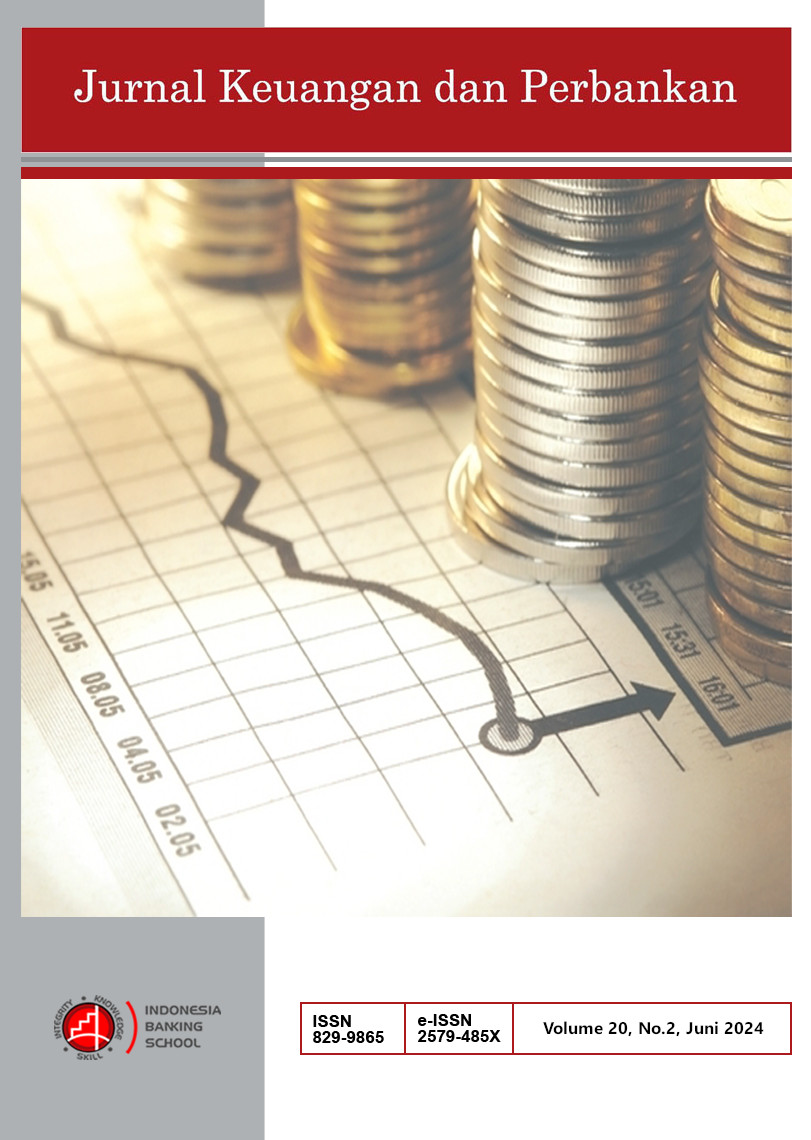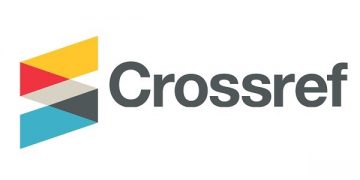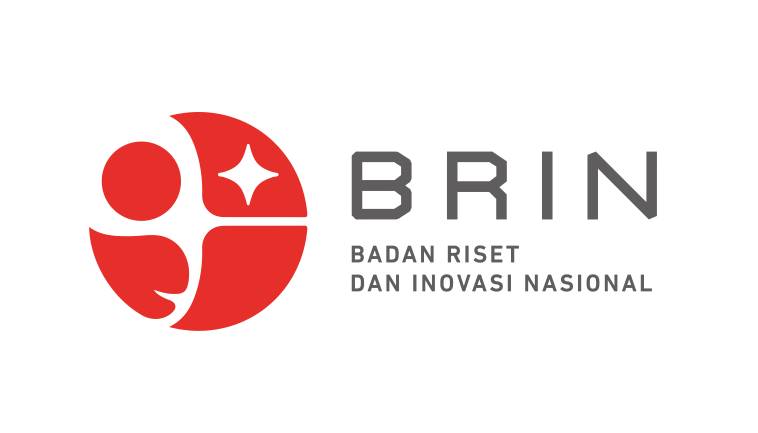Pengaruh Profitabilitas dan Likuiditas Terhadap Zakat Perusahaan Pada Bank Umum Syariah di Indonesia
DOI:
https://doi.org/10.35384/jkp.v20i2.566Keywords:
Return On Equity (ROE), Operating Expenses to Operating Income Ratio (BOPO), Financing to Deposit Ratio (FDR), Corporate Zakat, Islamic BanksAbstract
This research aims to determine the influence of profitability and liquidity on corporate zakat (Islamic almsgiving) for Islamic Commercial Banks in the period of 2021-2023 in Indonesia. The population of this study consists of Islamic Commercial Banks operating in Indonesia. The research employs purposive sampling as the sampling method. After selection, the sample includes four Islamic Commercial Banks: Bank Muamalat Indonesia, Bank Syariah Indonesia, Bank Mega Syariah, and Bank Panin Dubai Syariah. This research follows a quantitative approach using multiple regression analysis, and the analysis is conducted using SPSS. The research results indicate that the profitability variables, proxied by Return On Equity (ROE) and the Operating Expenses to Operating Income Ratio (BOPO), and the liquidity variable, proxied by Financing to Deposit Ratio (FDR), collectively have a positive and significant impact on corporate zakat. In partial testing, the Profitability variable, which is proxied by Return On Equity (ROE), has a significant positive influence on the company's zakat expenditure, while the Operating Costs, Operating Income (BOPO) has no effect on the company's zakat expenditure, and the Liquidity variable, which is proxied by the Financing to Deposit Ratio. (FDR) has a significant negative effect on company zakat expenditure. This explains how the profitability and liquidity of Islamic banks can affect their social obligations in paying corporate zakat, which is an important aspect of the Islamic economy in Indonesia.
References
Agustian, H., Ilham, R. N., Sinta, I., & Feinberg, B. (2023). Analysis Of Common Size On BSI (Bank Syariah Indonesia) In 2020-2021. Journal of Accounting Research, Utility Finance and Digital Assets, 1(3), 195–202.
Alfani, N. S. H., Syarief, M. E., & Dewi, R. P. K. (2022). Pengaruh Financial Performance terhadap Zakat Perusahaan dengan ROA Sebagai Variabel Intervening pada Bank Umum Syariah di Indonesia. Journal of Applied Islamic Economics and Finance, 2(3), 589–599.
Alfina, R., & Putra, P. (2021). ANALISIS KINERJA KEUANGAN LEMBAGA AMIL ZAKAT DENGAN METODE DATA ENVELOPMENT ANALYSIS (DEA)(Studi pada Lembaga Amil Zakat Dompet Dhuafa Republika). Paradigma, 18(1), 10–20.
Anam, H. (2023). Manajemen Risiko Operasional Bank Syariah; Teori dan Manfaat. Jurnal At-Tamwil: Kajian Ekonomi Syariah, 5(1), 16–31.
Anshori, A. G. (2018). Perbankan syariah di Indonesia. UGM press.
Azoitei, D. C. (2020). Critical Analysis of the Contemporary Application of Riba in Islamic Banking. J. Int’l L. Islamic L., 16, 76.
Batubara, Z. (2012). Analisis Metode Perhitungan Zakat Perusahaan. IQTISHADUNA: Jurnal Ilmiah Ekonomi Kita, 1(2), 205–232.
Elpina, A., & Lubis, H. (2022). Pengaruh kepercayaan terhadap keputusan membayar zakat di Badan Amil Zakat Nasional (BAZNAS). Journal of Sharia and Law, 1(1), 35–50.
Fatimatuzzahro, S. (2022a). Pengaruh Profitabilitas Dan Likuiditas Terhadap Pengeluaran Zakat Pada Bank Umum Syariah Di Indonesia Dengan Ukuran Perusahaan Sebagai Variabel Moderasi (2011-2020). Journal Economics And Strategy, 3(1), 24–39.
Fatimatuzzahro, S. (2022b). Pengaruh Profitabilitas Dan Likuiditas Terhadap Pengeluaran Zakat Pada Bank Umum Syariah Di Indonesia Dengan Ukuran Perusahaan Sebagai Variabel Moderasi (2011-2020). Journal Economics And Strategy, 3(1), 24–39.
Fitria, S., Danisworo, D. S., Miftahurrohman, M., & Andriana, M. (2022). Analisis Pengaruh Kinerja Keuangan terhadap Pengeluaran Dana Zakat Perusahaan pada Bank Umum Syariah. Journal of Applied Islamic Economics and Finance, 3(1), 152–164.
Hasanah, U. (2021). Analisis Potensi Penerimaan Zakat Melalui E-Commerce Pada Masa Pandemi Covid-19. Journal of Islamic Social Finance Management, 2(1), 122–134.
Heikal, M., Khaddafi, M., & Ummah, A. (2014). Influence analysis of return on assets (ROA), return on equity (ROE), net profit margin (NPM), debt to equity ratio (DER), and current ratio (CR), against corporate profit growth in automotive in Indonesia Stock Exchange. International Journal of Academic Research in Business and Social Sciences, 4(12), 101.
Hidayat, F. (2021). Analisis Pengaruh Rasio Profitabilitas Terhadap Kemampuan Perusahaan Untuk Mengeluarkan Zakat. Jurnal Tabarru’: Islamic Banking and Finance, 4(2), 488–498.
Iriani, A. F. (2019). Minat nasabah dalam penggunaan mobile banking pada nasabah Bank Syariah Mandiri Kota Palopo. Dinamis: Journal of Islamic Management and Bussiness, 2(2).
Khoerunisa, T., Senjiati, I. H., & Hidayat, Y. R. (2021). Faktor-Faktor yang Mempengaruhi Pengeluaran Zakat Perusahaan Bank Umum Syariah Periode 2016-2020. Prosiding Hukum Ekonomi Syariah, 262–265.
Khoiriyah, N. (2019). Pengaruh Zakat dan Corporate Social Responsibility terhadap Kinerja Bank Umum Syariah Di Indonesia. http://repo.iain-tulungagung.ac.id/11272/
Khoiriyah, U., & Putra, P. (2022). Analisis Jalur Pengaruh Pengambilan Keputusan Bertransaksi Melalui BSI Mobile. Jurnal Ilmiah Ekonomi Islam, 8(3), 2522–2535.
Khoiriyah, U., Syam, A. H. B., Larasati, L., Maulana, M. D., & Rahmawati, R. (2022). Analisis Profitabilitas Bank Syariah Swasta di Indonesia sebelum dan Sesudah Covid-19 (Dengan Menggunakan Metode Horizontal). Shafin: Sharia Finance and Accounting Journal, 2(1), 21–33.
Kijewska, A. (2016). Determinants of the return on equity ratio (ROE) on the example of companies from metallurgy and mining sector in Poland. Metalurgija, 55(2), 285–288.
Misuari, M., & Rahmawati, R. (2022). Pengaruh Capital Adequacy Ratio (CAR), Financing To Deposit Ratio (FDR), Non Performing Financing (NPF) dan Inflasi Terhadap Profitabilitas (Studi Kasus PT Bank Victoria Syariah Periode September 2013-2018). At-Tamwil: Journal of Islamic Economics and Finance, 1(1), 1–16.
Mohajan, H. K. (2020). Quantitative research: A successful investigation in natural and social sciences. Journal of Economic Development, Environment and People, 9(4), 50–79.
Putra, P. (2016). Analisis Faktor-Faktor yang Mempengarugi Intensi Muzaki Membayar Zakat: Sebuah Survey pada Masyarakat Kota Bekasi. MASLAHAH (Jurnal Hukum Islam Dan Perbankan Syariah), 7(1), 99–109.
Putrie, R. D. N., & Achiria, S. (2019). Pengaruh Rasio Profitabilitas Terhadap Zakat Perusahaan Pada Bank Devisa Syariah. Al-Azhar Journal of Islamic Economics, 38–48.
Rachmawati, S. K., Lutfillah, N. Q., & Ernawati, W. D. (2022). Apakah Profitabilitas Dan Ukuran Perusahaan Berperan Menentukan Keputusan Pembayaran Zakat? Imanensi: Jurnal Ekonomi, Manajemen, Dan Akuntansi Islam, 7(1), 23–32.
Rahim, A. (2015). Konsep Bunga Dan Prinsip Ekonomi Islam Dalam Perbankan Syariah. HUMAN FALAH: Jurnal Ekonomi Dan Bisnis Islam, 2(2), 1–15.
Rahim, S. (2017). Model pengelolaan zakat perusahaan. Jurnal Akuntansi Multiparadigma, 8(1), 200–215.
Rahman, M. T., Rosyidin, I., & Dulkiah, M. (2018). Promoting social justice through management of Zakat. Proceedings of the 1st International Conference on Recent Innovations, 1 No. 1.
Rahman, Md. M., Tabash, M. I., Salamzadeh, A., Abduli, S., & Rahaman, Md. S. (2022). Sampling Techniques (Probability) for Quantitative Social Science Researchers: A Conceptual Guidelines with Examples. SEEU Review, 17(1), 42–51.
https://doi.org/10.2478/seeur-2022-0023
Reni, A., & Ahmad, N. H. (2016). Application of theory reasoned action in intention to use Islamic banking in Indonesia. Al-Iqtishad: Journal of Islamic Economics, 8(1), 137–148.
Ritonga, B. Y., Siregar, B. G., & Windari, W. (2020). Pengaruh Kinerja Keuangan terhadap Kemampuan Membayar Zakat PT. BRI Syariah Periode 2011-2018. Journal of Islamic Social Finance Management, 1(2), 248–270.
Septiawan, H., & Bahri, E. S. (2019). Tinjauan Zakat Perusahaan Perspektif Syariah dan Regulasi. Kordinat: Jurnal Komunikasi Antar Perguruan Tinggi Agama Islam, 18(2), 339–375.
Sugiyono. (2018). Metode Penelitian Kuantitatif dan Kualitatif dan R&D. Alfabeta Bandung.
Suherman, D. (2020). Implementasi kebijakan pengelolaan zakat mal melalui badan amil zakat nasional kabupaten Garut tahun 2019. Hanifiya: Jurnal Studi Agama-Agama, 3 (2), 67–76.
Susilawati, N., Guspita, I., & Novriadi, D. (2021). Peran Nazhir Dalam Perlindungan Harta Wakaf. ZAWA: Management of Zakat and Waqf Journal, 1(1), 21–21. https://doi.org/10.31958/zawa.v1i1.3593
Wardana, G. K. (2023). Bukti pengeluaran zakat perusahaan pada bank syariah di Asia Tenggara: Profitabilitas dan likuiditas. Perisai: Islamic Banking and Finance Journal, 7(1), 92–106.
Wardani, D. K., & Handini, G. (2021). Profitabilitas Sebagai Pemoderasi Pengaruh Ukuran Perusahaan Terhadap Pengeluaran Zakat Perusahaan. AKURAT| Jurnal Ilmiah Akuntansi FE UNIBBA, 12(3), 57–63.









